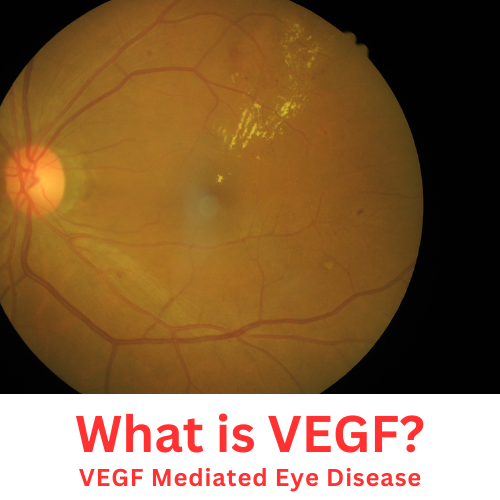Anti-VEGF Eye Injections


Vascular Endothelial Growth Factor (VEGF) is a protein that helps create and maintain blood vessels in the body. It plays important roles in healing wounds, supporting the growth of normal tissues, and developing blood vessels in embryos. It also helps transport essential substances, like oxygen and nutrients, through blood vessels.
While VEGF is essential for these processes, overproduction or dysregulation of VEGF can lead to medical conditions, particularly in eye diseases like diabetic retinopathy and wet age-related macular degeneration (AMD). In these conditions, excessive VEGF can result in the growth of abnormal blood vessels in the retina and leakage of fluid, which can cause loss of vision.
While VEGF is essential for these processes, overproduction or dysregulation of VEGF can lead to medical conditions, particularly in eye diseases like diabetic retinopathy and wet age-related macular degeneration (AMD). In these conditions, excessive VEGF can result in the growth of abnormal blood vessels in the retina and leakage of fluid, which can cause loss of vision.
The challenge is to target excessive or pathologic amounts of VEGF specifically within the eye. The goal is to reduce the abnormal growth of blood vessels in the retina without affecting the normal VEGF functions in other parts of the body.
To achieve this selective targeting, anti-VEGF drugs must be administered in a way that maximizes their effect within the eye while minimizing their impact on the rest of the body.
By injecting the drug into the eye, it can achieve a high concentration at the target site while bypassing much of the rest of the body’s circulation. This helps to avoid unwanted effects in other organs or tissues.
Intraocular injections (aka intravitreal injections) have become a standard and effective treatment for various retinal conditions, as it allows for precise control over the medication’s impact in the eye while sparing the beneficial effects of VEGF in other parts of the body.
Here is a list of reasons why intraocular injection is the preferred method for administering anti-VEGF to treat diabetic retinopathy and wet macular degeneration:
Targeted Local Action: Diabetic retinopathy and wet macular degeneration affect the blood vessels and tissues within the eye, especially the retina. The abnormal growth of blood vessels and leakage of fluid in the retina are localized issues. Intraocular injections allow the medication to be delivered precisely where it’s needed, with minimal systemic (whole-body) exposure. This targeted approach maximizes the drug’s effect in the eye while minimizing potential side effects in other parts of the body.
Blood-Retina Barrier: The eye has a protective barrier called the blood-retina barrier, which prevents or severely limits the passage of substances, including drugs, from the bloodstream into the retina. Oral medications, like pills, often face challenges in penetrating this barrier and reaching therapeutic levels within the eye. Intraocular injections bypass this barrier, ensuring a direct and effective delivery of the medication to the site of disease.
Dose Control: Intraocular injections allow for precise control over the dosage and frequency of treatment. Treatments can be tailored to the specific needs of the patient, ensuring the right amount of medication is delivered at the right time.
Minimized Side Effects: Many anti-VEGF drugs, such as Lucentis, Eylea, and Avastin, have potential side effects when introduced in the body. By administering them directly into the eye, the concentration of the drug in the bloodstream is much lower, reducing the risk of negative side effects. This is particularly important since diabetic retinopathy patients often have other health conditions such as hypertension that may require separate medications.
Maximized Effectiveness: Intraocular injections maximize the effectiveness of the treatment. By providing a high concentration of the medication directly to the affected area, these injections help to rapidly address the underlying cause of diabetic retinopathy and wet macular degeneration, which is the overproduction of VEGF in the eye.
The decision to use anti-VEGF therapy depends on your medical history, the severity of your condition, and the possible benefits and risks of the treatment in your particular case.
Gregory Scimeca, M.D.
Ophthalmologist and Medical Director
The Eye Professionals
Our Locations
